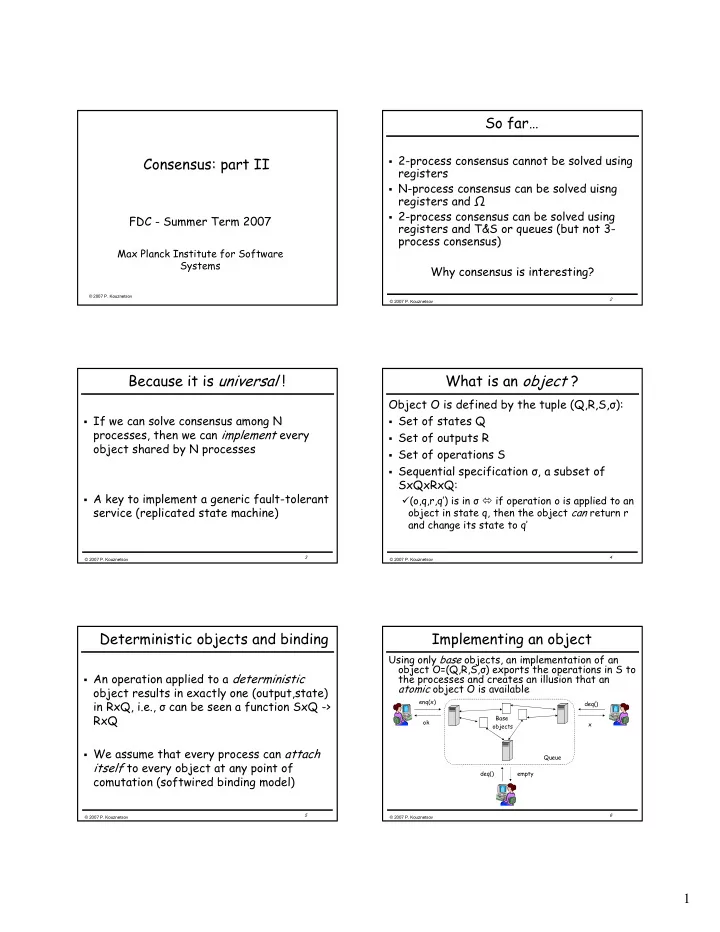

So�far… � 2�process�consensus�cannot�be�solved�using� Consensus:�part�II registers � N�process�consensus�can�be�solved�uisng registers�and�' � 2�process�consensus�can�be�solved�using� FDC�� Summer�Term�2007 registers�and�T&S�or�queues�(but�not�3� process�consensus) Max�Planck�Institute�for�Software� Systems Why�consensus�is�interesting? � ������������������ � � ������������������ Because�it�is� universal� ! What�is�an� object� ? Object�O�is�defined�by�the�tuple (Q,R,S,σ): � If�we�can�solve�consensus�among�N� � Set�of�states�Q processes,�then�we�can� implement every� � Set�of�outputs�R object�shared�by�N�processes� � Set�of�operations�S � Sequential�specification�σ,�a�subset�of� SxQxRxQ: � A�key�to�implement�a�generic�fault�tolerant� � (o,q,r,q’)�is�in�σ � if�operation�o�is�applied�to�an� service�(replicated�state�machine) object�in�state�q,�then�the�object� can return�r� and�change�its�state�to�q’ � � � ������������������ � ������������������ Deterministic�objects�and�binding Implementing�an�object Using�only base objects,�an�implementation�of�an� object�O=(Q,R,S,σ)�exports�the�operations�in�S�to� � An�operation�applied�to�a� deterministic the�processes�and�creates�an�illusion�that�an� atomic object�O�is�available object�results�in�exactly�one�(output,state)� enq(x) in�RxQ,�i.e.,�σ can�be�seen�a�function�SxQ �>� deq() RxQ Base� ok x objects � We�assume�that�every�process�can� attach� Queue itself to�every�object�at�any�point�of� deq() empty comutation (softwired binding�model) � � � ������������������ � ������������������ 1
Implementation:�definition Implementation:�correctness A�distributed�algorithm�A�that,�for�each� A�(wait�free)�implementation�A�is�correct�if� operation�o�in�S�and�for�every�pi,�describes� in�every�well�formed�run�of�A the�corresponding�sequence�of�steps�on�the� � ������������� every�operation�run�by�pi� base�objects returns�in�a�finite�number�of�steps�of�pi� � ���������������������� ≈ operations�“appear” instantaneous�(the�corresponding� history is� strictly�linearizable ) A�run�of�A�is� well�formed if�no�process�invokes�a� � The�formal�definition�follows new�operation�on�the�implemented�object�before� returning�from�the�old�one � � � ������������������ � ������������������ Histories Legal�histories A�history�of�a�given�run�of�A�is�a�sequence�of� A�sequential�history�is� legal if�it�satisfies�the� invocation�and�responses�on�the�implemented� sequential�specification�of�the�implemented� object�in�that�run object E.g.,�p1�>Q.enqueue(x),�p2�>Q.dequeue(),p1�>ok,���p2�>x,… A�history�is�sequential�if�every�invocation�is� Example:�LIFO�queues: followed�by�a�corresponding�response Every�dequeue()�returns�the�argument�of� E.g.,�p1�>Q.enqueue(x),�p1�>ok,�p2�>Q.dequeue(),��p2�>x,… the�last�enqueued element (A�sequential�history�has�no�concurrent�operations) � �� � ������������������ � ������������������ Complete�operations�and�completions Complete�operations�and�completions �������������� ������������� An�operation�op�is� complete in�H�if�H� p1 contains�invocation�and�response�of�op ����������������� A� completion of�H�is�a�complete�history�H’ that�contains�all�complete�operations�of�H� p2 ��������� ����� and�a� subset of�incomplete�operations�of�H� � completed�with� matching responses p3 ����������������������������������������������������� ������������������������ � ����������� ���!� �� �� � ������������������ � ������������������ 2
Strict�linearizability Complete�operations�and�completions A�finite�history�H�is� strictly�linearizable if�there� ������������ ������������ exists�H’,�a�legal�sequential�completion�of�H,�that� preserves�the�precedence�relation�of�H: p1 ���������������� op1�precedes�op2�in�H�=>�op1�precedes�op2���in�H’ p2 �������� (all�complete�operation�and�a�subset�of�incomplete� operations�can�be� linearized ) p3 An�implementation�is�strictly�linearizable if�every� ����������������������������������������������������� finite�run�of�it�produces�a�strictly�linearizable ������ � ���������� history �� �� � ������������������ � ������������������ Universal�construction Linearization ������������� ������������� p1 "#������� [Herlihy,�1991]�If�N�processes� ������������������������� can�solve�consensus,�then�N�processes�can� p2 (wait�free)�implement�every�object� ��������� O=(Q,R,S,σ) p3 ������������������������������������������������������ �������������� � ���������� �� �� � ������������������ � ������������������ Universal�construction:�idea Universal�construction:�variables Shared�abstractions: Every�process�that�has�a�pending�operation� N�atomic�registers�R[0,…,N�1],�initially�Ø does�the�following: N�process�consensus�instances�C[1],�C[2],�… � Publish�the�corresponding� request Local�variables�for�each�process�pi: integer� seq ,�initially�0�� � Collect�published�requests�and�use� //�the�number�of�executed�operations� consensus�instances�to�serialize�them:�the� integer� k ,�initiaqlly 0� processes�agree�on�the�order�in�which�the� //�the�number�of�linearized batches�of� requests�are�executed //�requests� sequence� linearized ,�initially�empty� //the�sequence�of�linearized requests �� �� � ������������������ � ������������������ 3
Recommend
More recommend